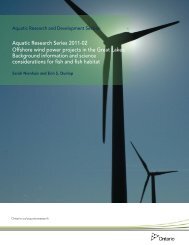Report of Research, Field Investigation and Survey of Robert D ...
Report of Research, Field Investigation and Survey of Robert D ...
Report of Research, Field Investigation and Survey of Robert D ...
You also want an ePaper? Increase the reach of your titles
YUMPU automatically turns print PDFs into web optimized ePapers that Google loves.
C.7 Pursuant to Volcanic Oil <strong>and</strong> Gas v. Chaplin, if the water rises to a level that crosses a fixed<br />
rectilinear (formerly upl<strong>and</strong>) boundary to the extent that a riparian parcel is completely<br />
inundated, the riparian parcel is completely extinguished. In the event that the water<br />
subsequently retreats, there is no longer any riparian parcel to which any new dry l<strong>and</strong> can<br />
attach.<br />
C.8 In other words, as waters encroach onto upl<strong>and</strong> geographic parcels, the boundaries<br />
dividing those geographics disappear as the inundated l<strong>and</strong>s on both sides <strong>of</strong> the former<br />
boundary are consolidated with the bed <strong>of</strong> the lake.<br />
On Page 13 <strong>of</strong> the decision, the Deputy Director writes: “When Tiny Township was first<br />
surveyed in 1821/1822 the road allowances would have been projected to the water’s edge as<br />
prescribed in Section 9 <strong>of</strong> the <strong>Survey</strong>s Act. Mr. Stewart explained that the level <strong>of</strong> Lake Huron<br />
reached its highest point in 1838 at 187.1 metres. Mr. Stewart explained that in accordance with<br />
the principles set out in Volcanic Oil <strong>and</strong> Gas the boundaries between the road allowances <strong>and</strong><br />
the adjoining lots would have been extinguished when they were covered by water. As the water<br />
receded, the l<strong>and</strong> being exposed is considered to be accretion <strong>and</strong> forms part <strong>of</strong> the l<strong>and</strong> to<br />
which it is attached. The principles set out in Paul v. Bates would apply to determine the location<br />
<strong>of</strong> the boundaries as they cross the accretion. In summary, on the assumption that the current<br />
topography is the same as, or the best available evidence <strong>of</strong>, the historical topography, the road<br />
allowance boundaries would be projected to intersect the 178.1 metre contour line, which is the<br />
extent <strong>of</strong> the accretion, <strong>and</strong> from that intersection would be perpendicular to the general line <strong>of</strong><br />
the shore at the water’s edge. A substantial bend would occur at the 178.1 metre contour line.<br />
The water’s edge frontage <strong>of</strong> Lot 18, Concession VII can then be determined.<br />
The decision was appealed (Ellard et al v. Township <strong>of</strong> Tiny [2012], ONSC 280), where Justice<br />
Lauwers strongly disagreed with the Deputy Director regarding his interpretation that the<br />
original subdivider had intended to develop all the l<strong>and</strong> he owned near the shore <strong>and</strong> was simply<br />
misinformed about what constituted his water side boundary.<br />
Following a lengthy review <strong>of</strong> the facts from the Boundaries Act Hearing Justice Lauwers says at<br />
Para 27 ‘In my view the Deputy Director went wrong when he concluded, as set out at para 11<br />
above, that “it cannot be assumed that Mr. Kitching was aware that his deed described to the<br />
“water’s edge” at the time he instructed Cavana about what he wished to subdivide, since at that<br />
time he had not yet received a deed.” It is hard to imagine that a l<strong>and</strong> developer, which is what<br />
Mr. Kitching plainly was, would not know fully both what he was getting <strong>and</strong> what he was<br />
selling in a project that took months to realize. In my view the Deputy Director overstates the<br />
significance <strong>of</strong> the dates.’<br />
Page 56 <strong>of</strong> 66
















